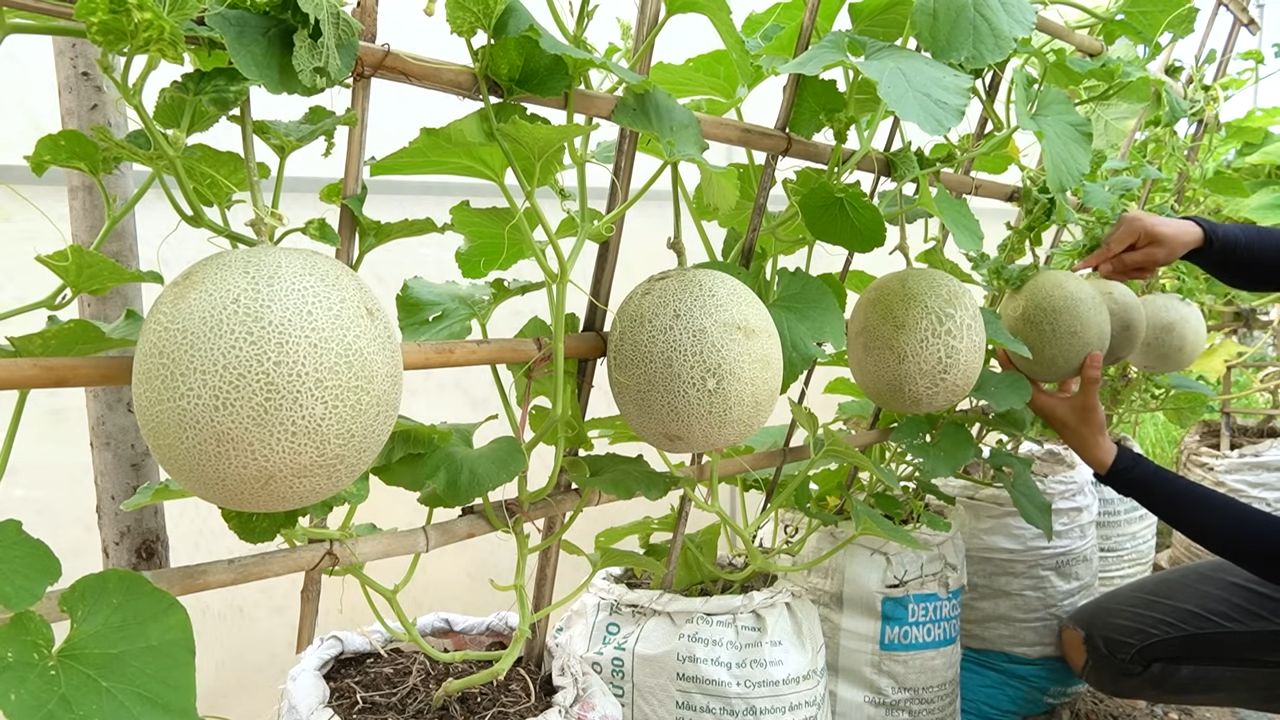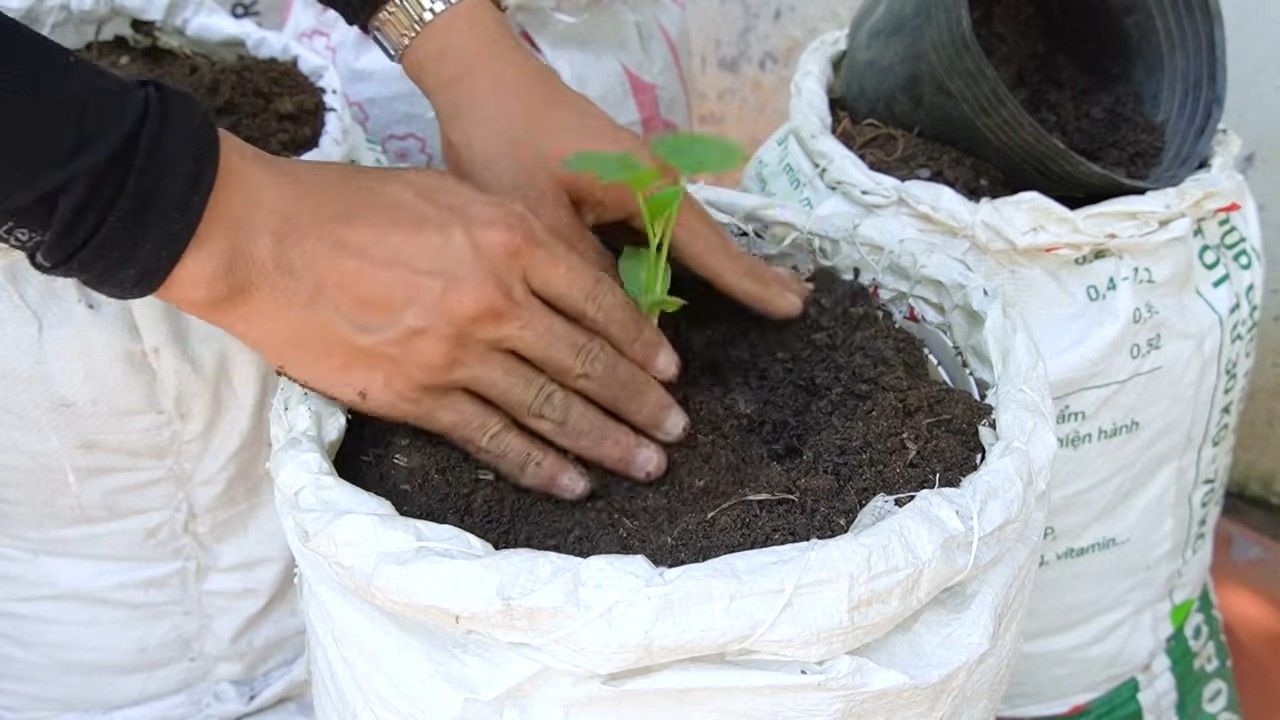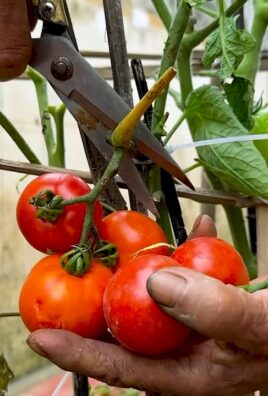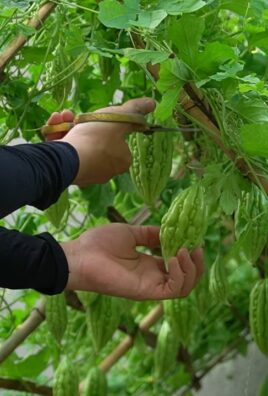Growing cantaloupes in grow bags might sound unconventional, but trust me, it’s a game-changer for home gardeners like us! Are you dreaming of juicy, sweet cantaloupes bursting with flavor, but limited by space or less-than-ideal soil? Well, you’re in the right place. For centuries, cantaloupes have been a symbol of summer abundance, gracing tables from ancient Egypt to modern-day picnics. But let’s face it, traditionally, growing these sun-loving melons required sprawling gardens and a whole lot of luck.
That’s where the magic of grow bags comes in! I’m going to show you how to bypass those limitations and cultivate your own delicious cantaloupes, even on a small balcony or patio. This DIY guide is packed with simple, effective tricks and hacks that will transform you into a cantaloupe-growing pro. Why struggle with poor soil drainage, limited space, or pesky pests when you can harness the power of grow bags?
Imagine biting into a perfectly ripe cantaloupe, knowing you nurtured it from seed to succulent fruit. It’s not just about the taste; it’s about the satisfaction of creating something amazing with your own two hands. So, let’s dive in and unlock the secrets to growing cantaloupes in grow bags – your taste buds (and your neighbors!) will thank you.

Growing Cantaloupes in Grow Bags: A Sweet Success Story!
Hey there, fellow gardening enthusiasts! I’m so excited to share my experience growing cantaloupes in grow bags. I know, it might sound a little unconventional, but trust me, it’s totally doable and incredibly rewarding. If you’re short on space or just want to try something new, growing cantaloupes in grow bags is the way to go. I’ve had some amazing harvests using this method, and I’m confident you can too!
Why Grow Cantaloupes in Grow Bags?
Before we dive into the how-to, let’s talk about why grow bags are such a great option for cantaloupes:
* Space Saving: Grow bags are perfect for balconies, patios, or small gardens where in-ground planting isn’t possible.
* Improved Drainage: Grow bags provide excellent drainage, preventing root rot, which cantaloupes are susceptible to.
* Better Aeration: The breathable fabric of grow bags allows for better air circulation around the roots, promoting healthy growth.
* Portability: You can easily move your cantaloupe plants around to follow the sun or protect them from harsh weather.
* Warmer Soil: Grow bags tend to warm up faster than the ground, giving your cantaloupes a head start in the spring.
What You’ll Need
Okay, let’s gather our supplies. Here’s what you’ll need to get started:
* Grow Bags: I recommend using at least 15-gallon grow bags per plant. Bigger is better, as cantaloupes need plenty of room for their roots to spread.
* Cantaloupe Seeds or Seedlings: Choose a variety that’s well-suited to your climate. I’ve had great success with ‘Athena’ and ‘Hales Best Jumbo’.
* High-Quality Potting Mix: Use a well-draining potting mix that’s rich in organic matter. Avoid using garden soil, as it can compact in grow bags.
* Compost: Compost is essential for providing nutrients to your cantaloupe plants.
* Slow-Release Fertilizer: A slow-release fertilizer will provide a steady supply of nutrients throughout the growing season. Look for one that’s specifically formulated for vegetables or fruits.
* Watering Can or Hose: You’ll need a way to water your plants regularly.
* Trellis or Support System: Cantaloupe vines can get quite long, so you’ll need a trellis or other support system to keep them off the ground.
* Gardening Gloves: Protect your hands from dirt and thorns.
* Pruning Shears: For trimming and pruning the vines.
* Mulch: Mulch helps retain moisture and suppress weeds. Straw or wood chips work well.
Getting Started: Planting Your Cantaloupe
Now for the fun part! Let’s get those cantaloupes planted.
1. Prepare the Grow Bag: Fill your grow bag about three-quarters full with your potting mix. Mix in a generous amount of compost and slow-release fertilizer according to the package directions.
2. Plant Your Seeds or Seedlings:
* From Seed: Sow 2-3 seeds per grow bag, about 1 inch deep. Water gently and keep the soil consistently moist. Once the seedlings emerge, thin them to one plant per bag.
* From Seedlings: Gently remove the seedling from its container and loosen the roots. Dig a hole in the potting mix that’s large enough to accommodate the root ball. Place the seedling in the hole and backfill with potting mix. Water thoroughly.
3. Mulch Around the Plant: Apply a layer of mulch around the base of the plant to help retain moisture and suppress weeds.
4. Install a Trellis or Support System: Set up your trellis or support system near the grow bag. As the cantaloupe vines grow, gently train them to climb the trellis.
Caring for Your Cantaloupe Plants
Once your cantaloupe plants are established, it’s important to provide them with the care they need to thrive.
1. Watering: Cantaloupes need consistent moisture, especially during hot weather. Water deeply whenever the top inch of soil feels dry to the touch. Avoid overwatering, as this can lead to root rot. I usually water every other day, but it depends on the weather.
2. Fertilizing: Cantaloupes are heavy feeders, so you’ll need to fertilize them regularly. In addition to the slow-release fertilizer you added at planting time, I like to supplement with a liquid fertilizer every 2-3 weeks. Use a fertilizer that’s high in phosphorus and potassium to promote fruit development.
3. Pruning: Pruning can help improve air circulation and encourage fruit production. Remove any yellowing or dead leaves. You can also prune the lateral vines (the ones that grow out from the main vine) to encourage the plant to focus its energy on fruit production. I usually prune the lateral vines back to about 1-2 feet long.
4. Pollination: Cantaloupes require pollination to produce fruit. If you’re growing your cantaloupes indoors or in an area with limited bee activity, you may need to hand-pollinate them. To hand-pollinate, use a small paintbrush to transfer pollen from the male flowers to the female flowers. The male flowers have a long, thin stem, while the female flowers have a small, immature fruit at the base.
5. Pest and Disease Control: Keep an eye out for common cantaloupe pests, such as aphids, squash bugs, and cucumber beetles. You can control these pests with insecticidal soap or neem oil. Cantaloupes are also susceptible to fungal diseases, such as powdery mildew and downy mildew. To prevent these diseases, provide good air circulation and avoid overhead watering. If you notice any signs of disease, treat the plants with a fungicide.
Training Your Cantaloupe Vines
Cantaloupe vines can get quite long and unruly, so it’s important to train them to grow on a trellis or support system. This will help keep the fruit off the ground, prevent rot, and improve air circulation.
1. Choose a Trellis or Support System: There are many different types of trellises and support systems you can use for cantaloupes. I’ve had good luck with A-frame trellises, wire mesh trellises, and even just simple stakes.
2. Train the Vines: As the cantaloupe vines grow, gently guide them to climb the trellis. You can use plant ties or twine to secure the vines to the trellis. Be careful not to tie the vines too tightly, as this can damage them.
3. Support the Fruit: As the cantaloupes grow larger, they may need additional support. You can use slings made from pantyhose or netting to support the fruit and prevent it from breaking off the vine.
Harvesting Your Cantaloupes
The moment we’ve all been waiting for! Harvesting your homegrown cantaloupes is one of the most rewarding experiences a gardener can have.
1. Check for Ripeness: Cantaloupes are ripe when they have a sweet aroma and the stem begins to slip easily from the fruit. The skin will also change color from green to a tan or yellow hue.
2. Harvest Carefully: Gently twist the cantaloupe from the vine. If it’s ripe, it should come off easily. If it doesn’t, it’s not quite ready yet.
3. Enjoy Your Harvest: Store your harvested cantaloupes in the refrigerator for up to a week. Enjoy them fresh, in salads, or in smoothies.
Troubleshooting
Even with the best care, you may encounter some challenges when growing cantaloupes in grow bags. Here are some common problems and how to solve them:
* Yellowing Leaves: Yellowing leaves can be a sign of nutrient deficiency, overwatering, or disease. Check the soil moisture and fertilize if necessary. If you suspect disease, treat the plants with a fungicide.
* Lack of Fruit: Lack of fruit can be caused by poor pollination, insufficient sunlight, or nutrient deficiency. Make sure your plants are getting at least 6-8 hours of sunlight per day and fertilize regularly. If you suspect poor pollination, try hand-pollinating the flowers.
* Fruit Rot: Fruit rot can be caused by excessive moisture or fungal disease. Make sure your plants have good air circulation and avoid overhead watering. If you notice any signs of rot, remove the affected fruit immediately.
* Pest Infestation: Pests can damage cantaloupe plants and reduce fruit production. Monitor your plants regularly for pests and treat them with insecticidal soap or neem oil as needed.
Extra Tips for Cantaloupe Success
* Choose the Right Variety: Select a cantaloupe variety that is well-

Conclusion
So, there you have it! Growing cantaloupes in grow bags isn’t just a trendy gardening experiment; it’s a game-changer for anyone with limited space, challenging soil, or simply a desire for a more controlled and rewarding gardening experience. We’ve explored the ins and outs, from selecting the right grow bag size and soil mix to providing optimal support and tackling common challenges.
But why is this DIY trick a must-try? Because it unlocks the potential to enjoy the sweet, juicy taste of homegrown cantaloupes, even if you live in an apartment with a balcony or have a yard plagued by poor drainage. It’s about taking control of your food source, reducing your carbon footprint, and experiencing the unparalleled satisfaction of nurturing a plant from seed to harvest.
Think of the possibilities! Imagine adding a trellis to your grow bag setup and training your cantaloupe vines vertically, creating a stunning green wall that also produces delicious fruit. Or, experiment with different cantaloupe varieties – perhaps a smaller, personal-sized cantaloupe or a unique heirloom variety you can’t find in stores. You could even try companion planting, adding herbs like basil or marigolds to your grow bag to deter pests and enhance the flavor of your cantaloupes.
The beauty of growing cantaloupes in grow bags lies in its adaptability. You can easily move your plants to chase the sun, protect them from unexpected frosts, or bring them indoors during extreme weather. It’s a flexible and forgiving method that allows you to tailor your gardening approach to your specific environment and needs.
We’ve armed you with the knowledge and inspiration to embark on your own cantaloupe-growing adventure. Now, it’s time to get your hands dirty! Don’t be afraid to experiment, learn from your mistakes, and most importantly, have fun. The reward of biting into a sun-ripened, homegrown cantaloupe is well worth the effort.
We are confident that with a little care and attention, you’ll be enjoying the fruits (literally!) of your labor in no time. So, grab your grow bags, select your seeds, and get ready to experience the joy of growing cantaloupes in grow bags.
And remember, gardening is a journey, not a destination. Share your experiences with us! We’d love to hear about your successes, your challenges, and any tips or tricks you discover along the way. Post photos of your cantaloupe plants, tell us about your favorite varieties, and let’s create a community of grow bag gardening enthusiasts. Happy growing!
Frequently Asked Questions (FAQ)
What size grow bag is best for growing cantaloupes?
The ideal grow bag size for cantaloupes is typically between 15 and 25 gallons. This provides ample space for the root system to develop and ensures the plant has enough nutrients and moisture. Smaller grow bags may restrict growth and lead to smaller, less flavorful fruits. Larger grow bags, while not necessarily harmful, may be more difficult to move and manage. A 20-gallon grow bag is often considered a sweet spot, offering a good balance of space and manageability.
What type of soil mix should I use in my grow bag?
Cantaloupes thrive in well-draining, nutrient-rich soil. A good soil mix for grow bags consists of equal parts of the following:
* **High-quality potting mix:** This provides a base for the soil and helps retain moisture.
* **Compost:** Compost adds essential nutrients and improves soil structure.
* **Perlite or vermiculite:** These materials improve drainage and aeration, preventing the soil from becoming waterlogged.
You can also add a slow-release fertilizer to the soil mix to provide a steady supply of nutrients throughout the growing season. Avoid using garden soil in grow bags, as it can become compacted and hinder drainage.
How often should I water my cantaloupe plants in grow bags?
Watering frequency depends on several factors, including the weather, the size of the plant, and the type of soil mix you’re using. As a general rule, water your cantaloupe plants deeply whenever the top inch of soil feels dry to the touch. During hot, dry weather, you may need to water daily. Avoid overwatering, as this can lead to root rot. Grow bags tend to dry out faster than traditional garden beds, so it’s important to monitor the moisture level regularly. Using a moisture meter can be helpful in determining when to water.
How much sunlight do cantaloupes need when grown in grow bags?
Cantaloupes are sun-loving plants and require at least 6-8 hours of direct sunlight per day to thrive. Choose a location for your grow bags that receives plenty of sunlight throughout the day. If you live in a particularly hot climate, you may need to provide some afternoon shade to prevent the plants from overheating. If you don’t have a sunny spot, you can supplement with grow lights.
Do I need to provide support for my cantaloupe vines in grow bags?
Yes, cantaloupe vines can become quite long and heavy, so providing support is essential. You can use a trellis, stakes, or even a tomato cage to support the vines. Training the vines to grow vertically not only saves space but also improves air circulation and reduces the risk of fungal diseases. Make sure the support structure is sturdy enough to handle the weight of the mature vines and fruits.
How do I know when my cantaloupes are ripe?
Determining when a cantaloupe is ripe can be tricky, but there are a few telltale signs to look for:
* **Color:** The skin of the cantaloupe should turn from green to a tan or yellowish color.
* **Aroma:** A ripe cantaloupe will have a sweet, musky aroma, especially near the stem end.
* **Stem:** The stem should easily slip from the vine with a gentle tug. If you have to force it, the cantaloupe is not yet ripe.
* **Sound:** When you tap on a ripe cantaloupe, it should sound hollow.
Once you’ve harvested your cantaloupe, store it in the refrigerator to prolong its freshness.
What are some common pests and diseases that affect cantaloupes in grow bags?
Cantaloupes are susceptible to several pests and diseases, including:
* **Aphids:** These small insects can suck the sap from the leaves, weakening the plant.
* **Squash bugs:** These pests can damage the leaves and stems of cantaloupe plants.
* **Powdery mildew:** This fungal disease causes a white, powdery coating on the leaves.
* **Fusarium wilt:** This soilborne disease can cause the plant to wilt and die.
To prevent pests and diseases, practice good sanitation, such as removing dead leaves and debris. You can also use organic pest control methods, such as insecticidal soap or neem oil. Choose disease-resistant cantaloupe varieties whenever possible.
Can I grow cantaloupes in grow bags indoors?
Yes, you can grow cantaloupes in grow bags indoors, but you’ll need to provide adequate light and ventilation. Use grow lights to supplement natural sunlight and ensure the plants receive at least 12-14 hours of light per day. Provide good air circulation to prevent fungal diseases. You may also need to hand-pollinate the flowers to ensure fruit production.
How do I fertilize my cantaloupe plants in grow bags?
Cantaloupes are heavy feeders and require regular fertilization. Use a balanced fertilizer (e.g., 10-10-10) or a fertilizer specifically formulated for melons. Fertilize every 2-3 weeks, following the instructions on the fertilizer label. You can also supplement with compost tea or other organic fertilizers. Avoid over-fertilizing, as this can lead to excessive vegetative growth and reduced fruit production.
Can I reuse grow bags for growing cantaloupes next year?
Yes, you can reuse grow bags, but it’s important to clean and sanitize them first. Remove any remaining soil and debris. Wash the grow bags with soap and water, and then disinfect them with a solution of bleach and water (1 part bleach to 9 parts water). Rinse the grow bags thoroughly and allow them to dry completely before storing them. You may also want to replace the soil mix each year to ensure optimal nutrient levels.





Leave a Comment